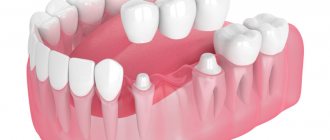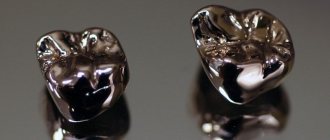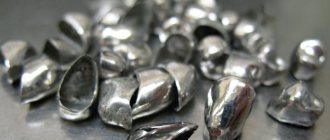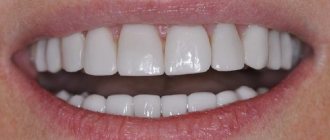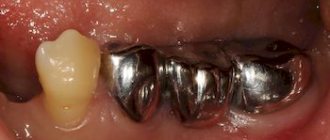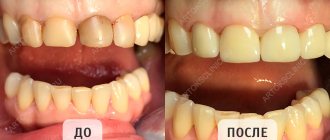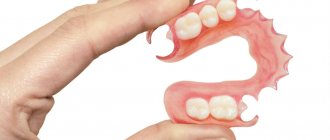Indications for the installation of porcelain crowns
The main indication for the installation of porcelain crowns is the aesthetic restoration of the front teeth:
· wedge-shaped defects and chips that cannot be eliminated using filling material;
Complete destruction of the dental crown;
· enamel hypoplasia;
Abnormalities in tooth color or shape;
· a pronounced change in the shade of tooth enamel that cannot be corrected using professional hygiene methods.
In addition, such designs are suitable for patients who are allergic to metal.
Plastic crowns
Installing plastic dental crowns is the most economical and efficient method of prosthetics. Their production occurs very quickly, so the patient can receive ready-to-use products in just one visit to a specialist. However, false teeth made of plastic are much more fragile and short-lived compared to their counterparts made of metal-ceramics or metal. In this regard, in most cases, such products are used as a temporary solution while more reliable crowns are made from other materials.
Stages of manufacturing and installation of porcelain crowns
First of all, at the appointment, the dentist examines the patient’s oral cavity, identifies possible contraindications, and, if necessary, carries out a complete sanitation. Only after this can you proceed to the next stage - preparing the tooth for a porcelain crown and selecting the optimal shade for the future design using a special template.
Next, the doctor takes a combined impression of the tooth and the entire dentition. And if the quality of the casts is satisfactory, it is sent to a dental laboratory, where a plaster model is made based on them.
Direct production of a porcelain crown can be carried out in two ways. The first involves layer-by-layer application of porcelain substance, and the second uses injection molding technology. It is the second option that is more modern and gives the structure high strength,
Therefore, it is used in most dental laboratories.
After the impression falls into the hands of a specialist, he uses thin platinum foil to create a mold for the future dental crown and fills it with a porcelain composition, and then exposes it to high temperatures several times.
The final stage of making a porcelain crown is the correction of the structure, its staining and glazing.
After the crown is ready, it is first tried on. If the result suits both the doctor and the patient, it is finally fixed on the previously prepared tooth.
A laboratory technician performs the following manipulations:
Making diagnostic models of jaws
- Making diagnostic models of jaws;
- Making temporary crowns (if they are not made directly by a doctor in the office using a silicone key - a special material is applied to the area of interest and retains its shape when hardened); as a rule, the help of a technician is required in case of severe initial destruction - in this case, he casts a model using an impression, models the damaged areas on it with wax, and from this structure, using a key, makes temporary restorations;
- Making working models from supergypsum based on final impressions;
- Making a wax reproduction of the final restoration followed by a step-by-step replacement of materials (for example, casting a base for a combined structure, followed by application and firing of ceramic mass).
In addition to the traditional manufacturing method, there is also the so-called milling from ready-made blocks on a computer-controlled machine (CAD/CAM technology, for example CEREC, EVEREST). Using an optical system, an impression is taken (essentially scanned) either of the prepared area directly in the oral cavity, or of a model, then the data is transferred to a computer, where the image is processed by a special program, a model of the future restoration is built, which can be corrected, and then sharpened and finalized ( painted and glazed to give a shine comparable to natural). Now this is the most accurate way to create structures of various sizes and lengths (up to the entire dental arch), because human involvement and therefore possible inaccuracies are reduced to a minimum. The next step will obviously be the development of 3D printing technologies.
Benefits of porcelain crowns
· High aesthetics. Porcelain has almost ideal optical characteristics. It very accurately conveys the natural shade and translucency that are characteristic of natural tooth enamel.
· Hypoallergenic design and inert material. Porcelain does not have thermal conductivity, so tooth sensitivity to temperature changes is reduced. Since the crown does not contain a single gram of metal, it can be installed in patients who are allergic to it.
· Long service life. With proper care, the structure will last a very long time, approximately 10-15 years, without losing its performance characteristics.
· Resistant to staining and darkening. Porcelain crowns do not lose their shade and shine, maintaining their original appearance for a long time.
· Minimum adaptation time. The patient quickly gets used to the lightweight and comfortable design.
· Easy to care for. Crowns do not require special care. It is enough to use a high-quality toothbrush and toothpaste, and treat them with care.
Advantages and disadvantages
Like all materials used in dentistry, plastic has certain advantages and disadvantages.
Advantages:
- Efficiency of production without the use of expensive specialized equipment.
- Availability for various categories of patients.
- Attractive appearance.
- The minimal weight of the material allows it to be used in cases where it is necessary to protect the jaw tissue from serious pressure from artificial teeth.
Flaws:
- Products are contraindicated for people who are prone to allergies to artificial polymers.
- Short service life (approximately 24 months).
- Rapid loss of original appearance (shade changes under the influence of various food colorings).
- High probability of chips and cracks.
- The porous structure provides poor hygiene characteristics (accumulation of microscopic food particles and various bacteria).
- The need to prepare a significant amount of dental tissue due to the impressive thickness of the crown.
Disadvantages of porcelain crowns
· High cost of construction. It is due to the complexity of technical work, which requires very high professionalism from a specialist.
· Relative fragility of the material. Patients have to avoid eating solid foods.
· Restrictions on indications. Porcelain crowns are not placed on all teeth.
· Manufacturing of single crowns only. Porcelain is not suitable for creating and installing bridges.
Plastic dentures
The structures are made from acrylic plastic and are used in cases of loss of one tooth or all elements of the dentition. Dentures of this type look very natural, since a shade is used for the base and teeth itself that perfectly matches natural tissues. In the case of complete edentia, plastic dentures rest only on the gingival tissue. Their fixation in the oral cavity occurs through a “closing valve” - a vacuum between the mucous membrane and the prosthesis. If several elements of the dentition are being restored, clasps (metal wires) are used to securely fasten the prosthesis. When replacing one tooth with prosthetics, butterfly prostheses are usually used, the attachment of which to the gum is carried out with special plastic extensions.
Varieties of porcelain designs
Dental porcelain is an excellent material that provides ample opportunities for aesthetic restoration. Several types of structures are made from it:
· Veneers. These are thin plates designed to hide minor defects in tooth enamel. They cover only the front surface of the tooth. Porcelain, composite or zirconium dioxide can be used in their manufacturing process.
· Tabs. These are microprostheses made in a dental laboratory. They help solve more serious dental problems with teeth and are used, for example, in cases of severe decay of the crown or the presence of a large carious cavity.
· Crowns. The most versatile design that allows you to achieve a “Hollywood” smile. They are installed on the front teeth during aesthetic restoration.
Indications and contraindications
Plastic crowns are indicated in the following cases:
- the need to use a temporary structure during the production of a permanent prosthesis;
- aesthetic function when changing the shape or shade of teeth in the smile area;
- a permanent solution for restoring the basic functions of dental elements in case of congenital pathologies, damage and caries.
Contraindications to the installation of plastic structures are:
- childhood;
- deep bite;
- presence of allergies to the material;
- bruxism (teeth grinding).
Metal ceramics or porcelain: what to choose?
This question arises among patients quite often. After all, each design has its own advantages and disadvantages. Thus, metal ceramics are distinguished by their high strength and affordable price, and porcelain has excellent aesthetic characteristics. Typically, the choice between them depends on which tooth needs to be restored. Crowns made of metal-ceramics are most often installed on chewing teeth, and porcelain crowns are installed on incisors and canines. However, if a porcelain crown has a zirconia framework, it can be used to restore any tooth.
Production stages
The production of plastic crowns takes place directly in the dental office and includes several stages.
- Preparation of the oral cavity for installation of a prosthesis and preparation of teeth.
- Obtaining impressions of the dentition using mouth guards with a special composition.
- Making a plaster model of dental elements.
- Formation of a crown on a model from a plastic mass pre-selected taking into account the natural color of the patient’s tooth enamel, followed by grinding and polishing of the product.
- Trying on and eliminating minor flaws.
- Final installation using temporary composites.
Contraindications for use
Experts do not recommend installing porcelain if, during an examination of the oral cavity, the doctor reveals certain conditions. Some of them:
- insufficient hardness of the dental bone tissue;
- inflammatory processes in the acute stage;
- severe occlusion disorders;
- chronic periodontal disease in the acute stage;
- absence of a large number of teeth.
All contraindications are considered absolute and have nothing to do with the fact that the material has high hardness and almost does not wear off. This often leads to overload of the periodontium of supporting teeth, thereby worsening the course of pathologies. In addition, there are a number of relative contraindications:
- bruxism (dysfunction of the masticatory muscles);
- “living” pulp of the incisors on the lower jaw;
- excessive abrasion of enamel;
- pathologies of occlusion, which are associated with strong crossing of the incisors.
When these limitations are eliminated by the method of complex treatment, the necessary conditions are created for the manufacture of porcelain prostheses.
Before and after installation
What determines the cost of a dental crown?
The final cost of prosthetics is influenced by several important factors:
Pricing policy for a specific dentistry: All private clinics target a specific cohort of consumers with approximately the same level of income. Therefore, the cost of the same prosthesis can vary dramatically. DENT Academy does not offer the lowest prices - we offer very high-quality work at an adequate cost.
Cost of materials: It is logical that plastic dentures are much cheaper than zirconium dioxide, so when choosing a specific type of dental crown, you should focus on your financial capabilities. Our clinic specialists will help you choose the best option that combines high quality with an affordable price.
The clinic has its own dental laboratory: The technological process of making dentures is financially very expensive. If there is no laboratory, the clinic is forced to enter into an agreement with an independent laboratory. Naturally, the cost of such prostheses will increase, if only because of logistics costs.
Qualification of personnel: it is natural that when a doctor with extensive experience and work experience receives more money for it, accordingly, the cost of his work will be higher than that of a young specialist who has no experience and whose quality of work is unknown. The price of dentures also includes the cost of paying for the work of a dental technician, whose qualifications largely determine the quality of the manufactured crown, especially when it comes to high-tech structures.
Prices
Free online consultation with a dentist
| Service | Price |
| Installation of a metal-ceramic crown (Germany Ivoclar, cobalt-chrome) | from 15,000 rub. |
| Installation of a metal-ceramic crown based on a bio-alloy - gold (Ivoclar Germany + cost of material according to the certificate) | from 25,000 rub. |
Consultation and diagnostics are free!
All prices Promotions
Sign up for a consultation
three ROOTT specialists + diagnostics as a gift
Advantages and disadvantages
Advantages
- High precision fit to dental tissues due to the correct anatomical shape;
- crown thickness is 0.3-0.5 mm, which avoids deep tooth preparation;
- durability – service life is 15-25 years;
- the possibility of spraying and cladding to improve the aesthetics of the structure;
- recreating the correct occlusion and chewing surface of the teeth;
- affordable price for manufacturing and installation.
Flaws
- Increased abrasion of the enamel of antagonist teeth;
- the need for turning;
- high thermal conductivity (due to the proximity of the pulp, discomfort and pain may occur);
- risk of allergies (except for structures made of precious metals);
- low aesthetics (excluding metal ceramics).
Prosthetic structures based on lithium silicate glass ceramics
Crowns made on the basis of lithium silicate glass ceramics are used in modern orthopedic and dental practice much less often than porcelain and zirconium prostheses. As a rule, this material is used for the manufacture of solid prosthetic structures that do not have a ceramic frame.
Disadvantages of lithium silicate glass ceramics
Despite all the advantages of lithium silicate glass ceramics (variety of shades, translucency), crowns made on its basis are considered relatively fragile and cannot be used for prosthetics of teeth experiencing significant chewing load.
It is important to remember that ceramic dentures cannot be installed for people suffering from:
- bruxism,
- mental illnesses,
- having a deep bite.
That is why, before prosthetics, it is necessary to obtain professional advice about the presence of side effects and contraindications from an experienced dentist at the orthopedic department of dentistry “A.Dent”.
Types of prostheses
Prostheses made of acrylic plastic are distinguished depending on the manufacturing technology:
- Pressed - are easy to make, but are not particularly convenient and highly detailed.
- Casting ones are more convenient to use, since a more precise manufacturing method is used, and their appearance completely corresponds to natural teeth.
Prostheses also differ in the ability to remove them by the patient himself:
- Removable - a person can remove the denture from the mouth for cleaning without the help of a specialist.
- Fixed - these dentures do not need to be removed to perform hygiene measures.
How is the color of the prosthesis selected?
To select the shade of new teeth, the Vita color scale is used. It looks like a small strip with enamel samples attached to it. The color range is indicated by the letters AD, with additional numerical markings from 1 to 4. The higher the number, the lighter the shade. The Vita scale includes 16 basic colors. Plus, there are special dyes, thanks to which you can achieve a complete shade identical to real teeth.
The choice of color is carried out in natural light, so as not to distort the perception of shades. The dentist takes each sample to the teeth in turn and determines the most optimal option.
Alternative Methods
Zirconium Durable crowns with high aesthetics, suitable for anterior and posterior teeth
Ceramic Esthetic crowns for single restorations and dental bridges (up to 3 units)
Metal-ceramic Inexpensive, durable crowns are chosen for premolars, molars and dental bridges (up to 4-5 units)
Article Expert
Meliksetyan Daniel Oganesovich Dentist-orthopedist, doctor of the highest category
Work experience: more than 17 years
What metal alloys are used
The designs have several options. Cast crowns are made from metal alloys with high strength:
- Chromium-cobalt alloys (CHS)
are high-alloy steels, characterized by density, elasticity, good fluidity (in the molten state), and high resistance to oxidation and corrosion.
The mechanical viscosity of CHS is higher than that of gold alloys. A prosthesis made from casting material based on chromium with the addition of cobalt and nickel is able to withstand high mechanical loads without deformation or destruction. The service life of such structures is 12-15 years
, and the price is the most affordable. The main disadvantages are poor aesthetics and the risk of developing allergies. - Gold-based alloys
are characterized by high strength and corrosion resistance.
The high plasticity of the material allows you to create dentures that fit exactly to the dental tissues and gums. Gold solid-cast tooth crowns have properties identical to natural enamel and do not damage opposing units. They have an antibacterial effect, are biocompatible with body tissues, and do not cause allergies or rejection. To give the material sufficient strength, gold is combined with palladium, platinum, copper, and silver. Service life - 20-25 years
. Cons: poor aesthetics, high price. - Titanium alloys
– the strength of titanium prostheses is 9-10 times higher than that of structures made from other materials. Biocompatible, inert to chemical and temperature influences, the material does not have a destructive effect on antagonist teeth. Prostheses made of titanium alloys are lightweight, have precise marginal and internal fit, and are used to compensate for single defects as part of long-distance bridges. Disadvantages - titanium is difficult to process and has low adhesion to ceramics, which increases the risk of chipping the outer coating.
The crown material is selected according to the clinical picture. The doctor takes into account the specifics of the situation, offers several effective options, among which the patient chooses the optimal one in terms of price, aesthetics, and functional properties. Metal-ceramic structures are more aesthetically pleasing than all-metal or metal-plastic crowns. Plastic cladding quickly absorbs foreign odors and coloring pigments, and changes color within a few months. It is not able to withstand a full chewing load and begins to crack and chip.
Care tips, service life
Proper and timely care allows patients to enjoy porcelain crowns for about 15 years. To extend the time of using reproductions, doctors advise:
- avoid impacts - do not bite off anything too hard, be careful when eating (do not hit the crowns with a spoon or cup);
- do not clench your jaw too much - if you have such a habit, you should take the time to learn how to control muscle tension or make sleep guards if you have bruxism;
- Do not combine cold and hot foods to prevent the ceramics from cracking (coffee with ice cream, hot drinks outside in freezing temperatures).
Care is quite simple: brush your teeth twice a day, and also visit the clinic for regular preventive examinations and hygiene. It is necessary for the doctor to examine the edges of the crowns so as not to miss the moment when decementing begins. If the seal is broken, cariogenic bacteria can get under the product.
Also, the dissolution of cement can accelerate with chronic inflammatory lesions of the gums, so be conscious of your health and consult with your dentists on all issues of concern.
Indications and contraindications
Experts highlight the following indications:
- A temporary solution while a permanent structure is being produced from more durable materials.
- A permanent solution for the loss of one or more elements of the dentition, including complete absence of teeth.
Contraindications:
- the presence of acute inflammation of the oral mucosa in the area of intended contact with the prosthesis;
- the presence of epilepsy or mental disorders;
- allergies to synthetic polymers;
- poor care of existing dental elements in the oral cavity.
How and why dental crowns are removed
A well-made dental crown can be worn for decades, of course, if the material from which it is made is designed for this. However, standard recommendations are to replace it every 10 years or more frequently as required.
Premature removal is carried out when certain unpleasant symptoms appear, most often indicating incorrect installation. So, crown removal is carried out when the following symptoms appear:
Crown pain
Although modern techniques for working with materials make it possible to ensure a filigree match of the crown to the prepared tooth, sometimes situations arise that the patient complains of pain in the crown. Of course, it is not the tooth that hurts, but the tooth on which it is installed. Among the causes of pain, caries is the leading cause; less often, pain occurs with untreated roots.
Unpleasant smell
The appearance of a putrid odor may be due to the fact that food particles are packed under the crown. Due to the inability to remove them even with the help of high-quality teeth cleaning, they become contaminated with bacteria and decompose, which is accompanied by a putrid odor.
What kind of crowns are placed on the front teeth?
The front incisors are not used for chewing food, so when prosthetics for this group of teeth there are more requirements for aesthetics and restoration of correct occlusion. But the material of the prosthesis must be strong enough to withstand the load when biting. To create crowns, metal alloys, metal-ceramics, ceramics (porcelain), zirconium oxide, E-max metal-free ceramics, plastic, etc. are used. The cost, appearance, and durability of the restoration depend on the material.

